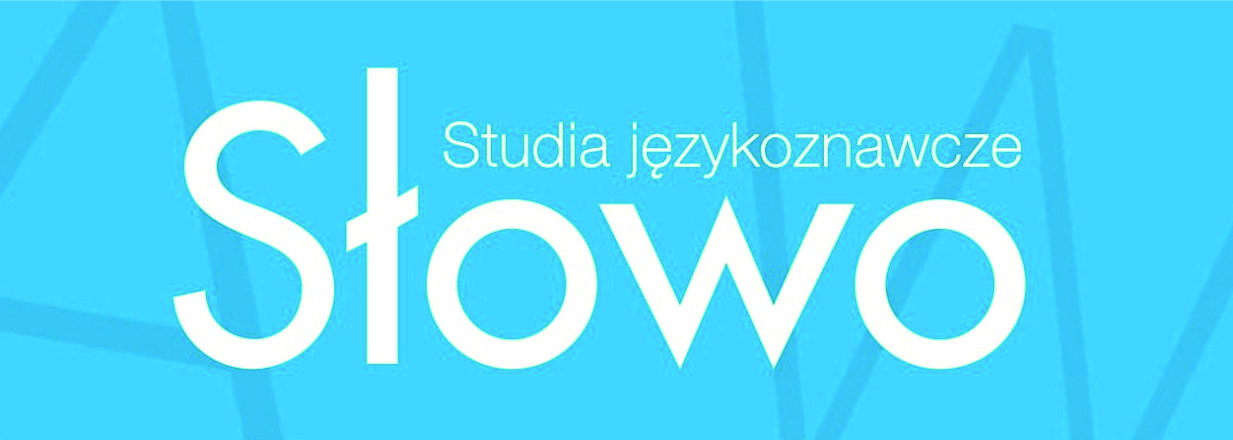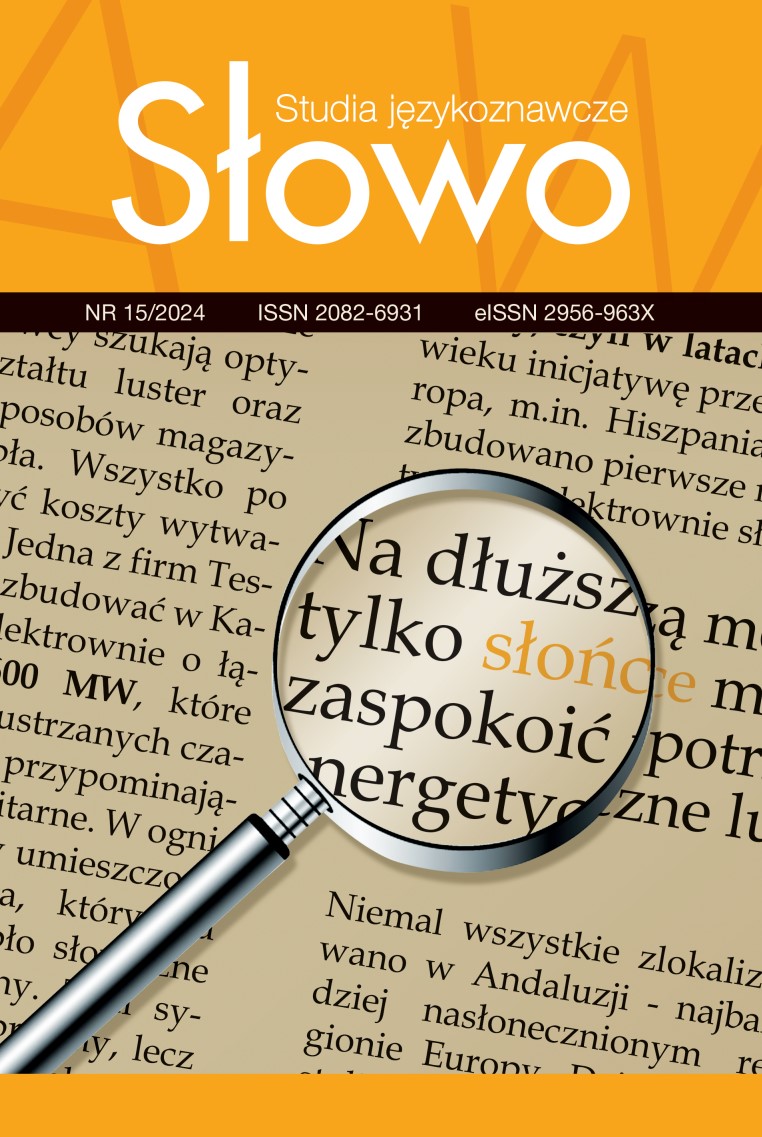Akty mowy i obrazu jako elementy konstruowania strategii perswazyjnych pracodawcy w przestrzeni internetowej
DOI:
https://doi.org/10.15584/slowo.2024.15.10Słowa kluczowe:
multimodalność, hipertekst, oferta pracy, strategie perswazyjne, promocja wizerunku pracodawcyAbstrakt
Punktem wyjścia do rozważań jest stwierdzenie Stöckla (2003, s. 307), że „tekst multimodalny wypiera stopniowo tekst monomodalny i tworzy podstawowy prototyp komunikacji międzyludzkiej”. Rozwój Internetu przyczynił się do integracji warstw językowej i graficznej na jednej płaszczyźnie wizualnej, co ułatwia przyciąganie uwagi odbiorcy, a nawet sterowanie jego zachowaniem i emocjami.
Perswazyjne kombinacje tekstu i obrazu są istotne również w kontekście rekrutacji pracowników w sferze online. Opierając się na klasyfikacji aktów mowy (najmniejszych jednostek działania językowego) i aktów obrazu (najmniejszych jednostek komunikacji wizualnej), ukazano ich wzajemne zależności w hipertekstualnych ofertach pracy służących pozyskaniu pracowników oraz promowaniu wizerunku pracodawcy. Perspektywa międzykulturowa pozwala na prześledzenie strategii perswazyjnych na stronach wybranych przedsiębiorstw polskich i niemieckich.
Downloads
Bibliografia
Austin, J.L. (1962). How to do Things with Words: The William James Lectures delivered at Harvard University in 1955 (Edited by J. O. Urmson). Oxford: Clarendon Press.
Brandt, M., Rosengren, I. (1992). Zur Illokutionsstruktur von Texten. Zeitschrift für Literaturwissenschaft und Linguistik 86, 9–51.
Klemm, M., Stöckl, H. (2011). Bildlinguistik – Standortbestimmung, Überblick, Forschungsdesiderate. W: Diekmannshenke, H., Klemm, M., Stöckl, H. (red.), Bildlinguistik. Theorien – Methoden– Fallbeispiele (s. 7–18). Berlin: Erich Schmidt.
Kress, G., Leeuwen, T. van (1996). Reading Images: The Grammar of Visual Design. London:Routledge.
Kress, G., Leeuwen, T. van (2001). Multimodal Discourse: The Modes and Media of Contemporary Communication. London: Arnold.
Lenk, H.E.H. (2012). Von der Illokutionsstruktur zum Handlungsweg. W: Lenk, H.E.H., Vesalainen, M. (red.), Persuasionsstile in Europa (s. 115–158). Hildesheim–Zürich–New York: Olms.
Lévy-Tödter, M. (2017). „Ignite your caree... Drive your future...“ Empowerment durch Sprache und Bilder in der Ansprache von Ingenieuren in digitalen und gedruckten Stellenanzeigen. W: Nielsen, M., Luttermann, K., Lévy-Tödter, M. (red.), Stellenanzeigen als Instrument des Employer Branding in Europa. Interdisziplinäre und kontrastive Perspektiven (s. 31–54). Wiesbaden: Springer.
Motsch, W., Viehweger, D. (1981). Sprachhandlung, Satz und Text. W: Rosengren, I. (red.), Sprache und Pragmatik. Lunder Symposium 1980 (s. 125–153). Malmö: CWK Gleerup.
Schmitz, U. (1996). Zur Sprache im Internet. Skizze einiger Eigenschaften und Probleme. W: Rainer F. (red.), Media paradise. Die multimediale Zukunft von Kindern und Jugendlichen (s. 89–105). Oldenburg: bis.
Schmitz, U. (2007). Bildakte? How to do things with pictures. Zeitschrift für germanistische Linguistik 35.3, 419–433.
Scholz, O.R. (1998). Was heißt es, ein Bild zu verstehen? W: Sachs-Hombach, K., Rehkämper, K. (red.), Bild – Bildwahrnehmung – Bildverarbeitung. Interdisziplinäre Beiträge zur Bildwissenschaft (s. 105–117). Wiesbaden: Deutscher Universitätsverlag.
Searle, J.R. (1971). Sprechakte. Ein sprachphilosophischer Essay. Frankfurt/Main: Suhrkamp.
Searle, J.R. (1979). Intentionalität und der Gebrauch der Sprache. W: Grewendorf, G. (red.), Sprechakttheorie und Semantik (s. 149–170). Frankfurt/Main: Suhrkamp.
Sikora, J. (2017). Uwagi nt. illokutywnej funkcji asertywnych aktów mownych. Lingwistyka Stosowana 20: 1/2017, 127–133.
Skowronek, B. (2013). Mediolingwistyka. Wprowadzenie. Kraków: Wydawnictwo Naukowe Uni-
wersytetu Pedagogicznego.
Skowronek, B. (2024). Mediolingwistyka. Dekadę później. Kraków: Uniwersytet Pedagogiczny w Krakowie.
Stöckl, H. (2003). ‚Imagine’: Stilanalyse multimodal – am Beispiel des TV-Werbespots. W: Barz, I., Lerchner, G., Schröder, M. (red.), Sprachstil – Zugänge und Anwendungen (s. 305–323). Heidelberg: Universitätsverlag Winter.
Stöckl, H. (2004). Typographie: Gewand und Körper des Textes – Linguistische Überlegungen zu typographischer Gestaltung. Zeitschrift für Angewandte Linguistik 41, 5–48.
Stöckl, H. (2012). Medienlinguistik. Zu Status und Methodik eines (noch) emergenten Forschungs-
feldes. W: Grösslinger, Ch., Held, G., Stöckl, H. (red.), Pressetextsorten jenseits der ,News‘. Medienlinguistische Perspektiven auf journalistische Kreativität (s. 13–34). Frankfurt/Main: Lang.
Stöckl, H. (2016). Multimodalität – Semiotische und textlinguistische Grundlagen. W: Klug, N.-M.,
Stöckl, H., (red.), Handbuch Sprache im multimodalen Kontext (s. 3–35). Berlin/Boston: De Gruyter.
Szwed, I. (2014). Zum Ausdruck von Intentionen in deutschen und polnischen Geschäftsbriefen aus kontrastiver Sicht. Eine textlinguistische Untersuchung. Frankfurt/Main: Lang.
Szwed, I. (2015). Styl internetowych ofert pracy w ujęciu kontrastywnym polsko-niemieckim. Stylistyka XXIV, 403–422.
Szwed, I. (2025, w druku). Das persuasive Potenzial multimodaler externer Unternehmenskommunikation mit potenziellen Bewerber:innen. W: Opiłowski, R., Lenk, H., Mikołajczyk, B.,
Rentel, N. (red.), Argumentation, Persuasion und Manipulation in Medientexten und -diskursen. Beiträge zur kontrastiven Medienlinguistik (s. 177–195). Göttingen: V&R unipress.
Weigand E. (2003). Sprache als Dialog: Sprechakttaxonomie und kommunikative Grammatik. Tübingen: Niemeyer.
Pobrania
Opublikowane
Jak cytować
Numer
Dział
Licencja
Prawa autorskie (c) 2024 Słowo. Studia językoznawcze

Utwór dostępny jest na licencji Creative Commons Uznanie autorstwa – Użycie niekomercyjne 4.0 Międzynarodowe.


